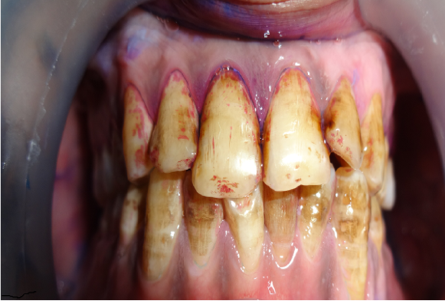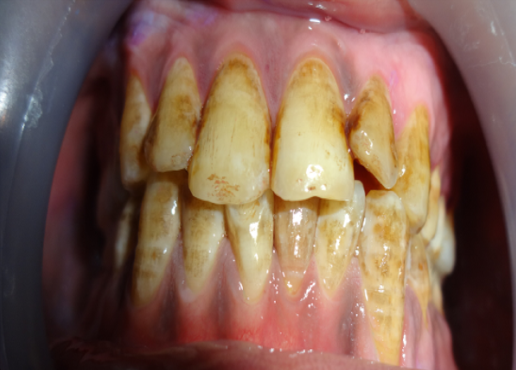Introduction
Chemical erosion is the loss of exterior tooth material by chemical action. Erosion may be eminent in sufferers with habits such as continuous citrus gulping (like lemon chewing), contact with chlorinated water, uninterrupted exposure to airborne acids or problems related to digestive systems that build frequent exposure of teeth to gastric acids.1 Dental erosion is an irremediable lesion which causes altered appearance and function and in due course leads to tooth loss. It can imply on any tooth surface, but it is seen oftenly on the facial, occlusal, and lingual areas. Erosion is generally examined to be the most widespread cause of tooth wear in the UK and Europe.2, 3, 4 Dental erosion is pathologic long standing deprivation of dental hard tissues due to the chemical affect of extrinsic and intrinsic acids without bacterial collaboration. Increased susceptibility to mechanical abrasion by tooth brushing is correlated with demineralization and dissolution of the tooth areas. Evolution of dental erosions exist from high pH, phosphate & calcium assemblage and the fluoride content thus governing dissolution. Development and progression of erosion may depend upon behavioral and biological factors, i.e. quality of dental tissues, tooth position and other salivary factors including composition, flow rate and buffer capacity.5
Table 1
Numerous terminologies related to tooth surface loss2
Table 2
Causes of erosion2
Case Report
A twenty-three -year-old patient reported to the outpatient department with a chief complain of worn out front teeth during the past 3 years. The patient narrated that he had a history of brushing teeth with toilet cleaner i.e hydrochloric acid once, three years back. There was no history of stains, discolorations previously. The patient narrated - he took acid in a lid and dipped brush in it then he brushed the teeth, he added that he had thought of teeth whitening. Immediately he felt a burning sensation in oral cavity, following which he rinsed with water. Then after few weeks he noticed concavities on the tooth surface. Later on he started noticing brownish discolorations on the teeth as well. His medical and family histories were noncontributory. Patient had poor oral hygiene, he brushes once a day without toothpaste. On examination crescent shaped lesion on buccal and labial surfaces of the teeth. Various stages of lesion can be seen on the teeth. Severe concavities were present on the canines with white spot lesion shown on labial surfaces of incisors. On examination eroded lesions in all teeth were visible. Eroded tooth surface was smooth. Patient had no carious lesions and periodontium was healthy without any lesions. Scaling, root planing and polishing were done and plaque score (Silness P and Loe H)6 was taken prior to the treatment. Scores were noted and interpretation was fair. After treatment there was minimal changes seen in stains & discoloration. Then different aesthetic treatment options were advised which included Laminates and Veneers but patient was not willing for these restorative therapies.
Discussion
In this above case, the lesions of patient specified severe destruction due to brushing with hydrochloric acid. White spots confirmed the diagnosis of erosion along with concavities of brownish discolorations. However, literature is replete with myriads of reports emphasizing that various acids causes dental erosions and damages to other body tissues too.
Hartnett K M et al. 20117 explored the consequences of household chemicals on various human tissues i.e tooth, bone, hair, fingernails, and soft tissues submerged into six various corrosive agents. Medium consisted of hydrochloric acid organic septic cleaner, Coca-Cola soda, sulfuric acid lye and bleach. Tap water was used as a control. Upon winding up it was found that hydrochloric acid was the most catastrophic followed by sulfuric acid. Although Bleach, lye, and cola had no constitutional effects on the hard tissues of the body, but did change the aspect of the hair, nails, or flesh. Trapp BM et al. 20188 examined the consequences of household corrosive products on 105 restored and non-restored teeth. A household product includes sulfuric acid hydrochloric acid and detergent. After gathering information, it was found hydrochloric acid had the most catastrophic effects mainly to non-restored and restored teeth followed by sulfuric acid. Cope DJ et al. 20099 considered the effects of household chemical products on dentition. Corrosive chemicals include sulfuric acid, sodium hydroxide and phosphoric acid and hydrochloric acid. To sum up hydrochloric acid is the most deleterious substance. Sulfuric acid enacted minimal alterations, whereas Phosphoric acid resulted in variable changes. But sodium hydroxide results in little or minimal change. Jadhav KB et al. 200910 studied the effect of acids on the teeth and results showed that teeth could be wholly break down in 37% hydrochloric acid. Similar studies have been piled up with deleterious effects of sulfuric acids chromic acid and carbonated beverages. Occupational dental erosion is seen in wine tasters and battery industry manufacturers. Hattab FN et al. 202011 studied oral and general status of battery industry workers and come to an end that cases with unprotected workers in battery place suffer a lot of serious oral and general health problems. Dulgergil C T et al. 200712 presented a case report which assembled the information and found that dental erosion was caused as a consequence of working in industry and chromic acid was responsible for this case. Wiegand, A et al. 20075 reviewed article and described occupational dental erosion to acids and investigated in one of the study that78 % Swedish wine tasters undergoing frequent sessions of wine tasting each week i.e. 2 to 5 sessions were found having dental erosion. Cheng R et al. 200913 reviewed a paper and presented a case report and found severe worn out teeth in patients having a habit of drinking carbonated drinks about 1.5 L per day.
As far as literature is concerned, studies showing the effect of household acids on human dentition were seen mainly either in extracted teeth or in dentition of patients having occupational hazards and individuals having over consumption of carbonated drinks, but no data was found showing the effect of acid used intentionally by the patient for tooth whitening.
Conclusion
To conclude it can be averred that dental erosion may be caused due to various acids like sulfuric, phosphoric, hydrochloric, chromic acids along with wine tasting or usage of carbonated drinks. Among all acids, hydrochloric acids proved to be most deleterious substance for dental erosion. Therefore, it is advisable to communicate oral health education to them, to intimate them of the ill effects of hazardous substances. Thus awareness programs and local group discussions are essential for improving the oral health status of the general population.


